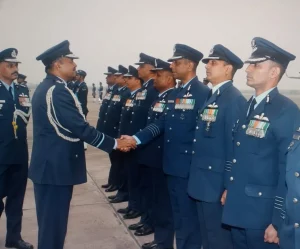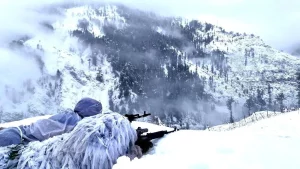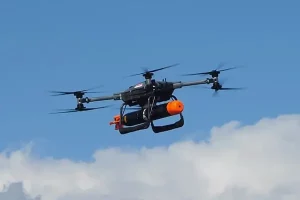India, Japan conduct naval exercise amid China row
- At a time when India and China are locked in a major troop confrontation in eastern Ladakh, Indian and Japanese warships held a small exercise towards the Malacca Strait in the Indian Ocean Region (IOR) on Saturday.
- Indian warships patrolling the region, Rajput-class destroyer INS Rana and Kora-class missile corvette INS Kulish, took part in the exercise with JS Shimayuki and JS Kashima from the Japanese Maritime Self-Defence Force’s training squadron. Though it was “largely a PASSEX (passing exercise)”, it definitely amounts to some strategic signalling for China, said sources.
- Three American aircraft carriers, USS Ronald Reagan, USS Theodore Roosevelt and USS Nimitz, incidentally, are also currently deployed in the Pacific Ocean for the first time in recent years, in a move that has not gone down well with China. Japan has become a regular participant in the high-voltage “Malabar” naval combat exercise between India and the US since 2015, with the three countries being concerned about China’s aggressive muscle-flexing in the Indo-Pacific region, especially in the South China Sea. The exercise is slated to be held in the Bay of Bengal later this year.
- Cranking up their bilateral military ties, India and Japan have also kicked off an annual joint land military exercise named “Dharma Guardian” since 2018. The two countries, after holding their first “two-plus-two” defence and foreign ministerial dialogue in November last year, are also now finalising a reciprocal military logistics pact to further strengthen their strategic partnership.
- India has already inked such pacts with the US, France, South Korea, Singapore and Australia to extend its naval operational reach to counter China’s expanding footprint in the IOR, which is witnessing regular forays by PLA warships and submarines.
- China had strongly objected to the India-US Malabar exercise in the Bay of Bengal in 2007 when it was expanded to include Japan, Australia and Singapore. India had then restricted Malabar to a bilateral one with the US for several years, including Japan only when the exercise was held in the north-western Pacific in 2009 and 2014, to avoid antagonising China.
Raksha Mantri Shri Rajnath Singh launches online portal for issue of NOC for power, oil, and gas exploration projects
- Raksha Mantri Shri Rajnath Singh in the presence of Raksha Rajya Mantri Shri Shripad Y Naik today launched a new web portal for issue of No Objection Certificate (NOC) for power projects and Research Survey Exploration Exploitation (RSEE) activities in the Indian Territorial Waters (TW) and Exclusive Economic Zone (EEZ).
- Ministry of Defence (MoD) accords security clearances to various private/Public Sector Undertakings (PSUs)/Government organisations for power/wind/solar projects in areas nearby defence installations and also RSEE activities in the Indian TW and EEZ for applications received through different Ministries like Ministry of New and renewable Energy (MNRE), Ministry of Power, Ministry of Petroleum & Natural Gas, Ministry of Shipping, Director General of Hydrocarbons, etc.
- To ensure ease of business and transparency in issuing NOC for such projects, the Ministry has developed the online application portal with the assistance of National e-Governance Division (NeGD), Bhaskaracharya Institute for Space Applications and Geo-informatics (BISAG) and National Informatics Centre (NIC). The address for the new online portal is https://ncog.gov.in/modnoc/home.html.
- The newly developed MoD web portal will facilitate the applicants in submitting their proposals online for seeking MoD Security Clearance for undertaking Power Projects/RSEE activities. The Online System will establish an effective, speedy, and transparent mechanism to process these proposals. The Ministry has earlier launched a similar portal for grant of NOC for aerial survey.
- Chief of Defence Staff & Secretary Department of Military Affairs General Bipin Rawat, Chief of Army Staff General M M Naravane, Chief of Naval Staff Admiral Karambir Singh, Chief of Air Staff Air Chief Marshal R K S Bhadauria and Defence Secretary Dr Ajay Kumar and other senior officials of MoD were present on the occasion. Senior officials of other concerned Ministries joined the event through video conferencing.
Indian Navy intensifies surveillance in Indian Ocean region to track Chinese activities
- To counter China’s repeated efforts to expand military influence in the resource-rich Indo-Pacific region, the navies from the US, India, Australia, Japan, and France have been increasing their mutual cooperation.
- In the wake of Chinese Navy’s aggressive posturing in South China Sea and Indo-Pacific region and the border standoff between India and China in Ladakh, these exercise have gained major significance.
- Amidst Chinese Navy’s regular forays in the Indian Ocean Region, the Indian Navy was asked to raise its alert level.
India, China to hold third round of Lt General talks today
- Top Army officers from India and China will meet for the third time today in a bid to de-escalate border tensions and reduce military build-ups, amidst the continuing stalemate triggered by Chinese troop intrusions into Indian territory in Pangong Tso, Galwan Valley, Hot Springs and Depsang Plains in eastern Ladakh.
- Sources said 14 Corps commander Lt-General Harinder Singh and South Xinjiang Military District chief Major General Liu Lin will kick off their meeting at the Chushul-Moldo border personnel meeting (BPM) point around 10:30 am.
- The meeting will take place for the first time at Chushul, unlike the first two marathon meetings held at Moldo on June 6 and 22, ever since the major troop confrontations between the two nuclear powers began in early-May.
First batch of six Rafale jets likely to arrive in India by July 27; to be based in Ambala
- India is likely to receive by July 27 the first batch of six Rafale fighter jets which are expected to significantly boost the combat capability of the Indian Air Force.
- The IAF has been on a high alert for the last two weeks in view of escalation in tension with China following clashes between troops of the two countries in Galwan Valley in eastern Ladakh in which 20 Indian Army personnel were killed. The two armies are locked in a bitter standoff in the region for seven weeks.
- India had signed an inter-governmental agreement with France in September 2016 for procurement of 36 Rafale fighter jets at a cost of around Rs 58,000 crore.
- On June 2, Defence Minister Rajnath Singh held a telephonic conversation with his French counterpart Florence Parly during which she conveyed that the Rafale jets will be delivered to India as scheduled notwithstanding the coronavirus pandemic in France.
- The first squadron of the aircraft will be stationed at Ambala air force station, considered one of the most strategically located bases of the IAF.
- The aircraft is capable of carrying a range of potent weapons. European missile maker MBDA’s Meteor beyond visual range air-to-air missile and Scalp cruise missile will be the mainstay of the weapons package of the Rafale jets
South Korea’s new air defense system enters full-rate production
- South Korea’s Defense Acquisition Program Administration (DAPA) awarded the Hanwha Defense a full-rate production contract for the new Anti-Aircraft Gun Wheeled Vehicle System (AAGW). Hanwha Defense won a $207.66 million for a contract to launch full-rate production of the newest Republic of Korea’s advanced air defense system.
- The AAGW is the latest air defense system to defend the points of interest for allied forces, as well as protect friendly mobile troops from low altitude attacks by enemy aircraft. Using a wheeled vehicle platform, it is able to provide close-in support to supported forces. The system is also capable of self-targeting threats with the help of electron-optical and visual targeting equipment.
- AAGW has a firing range of 3 kilometres, 1.6 times longer than the Vulcan. It requires 18 personnel for company-level operation, versus 48 for the VADS.
- It is equipped with an Electro Optical Targeting System (EOTS) developed by Hanwha Systems Co., one of around 200 firms, mostly South Korean ones, that have formed a team for the development program.
- AAGW is expected to help enhance the military’s low altitude air defense capability against low-flying aircraft and drones, according to DAPA.
South Korea to acquire new airborne early warning and control aircraft
- South Korea’s Defense Project Promotion Committee approved on 26 June plans to acquire more airborne early warning and control (AEW&C) aircraft from overseas as part of efforts to beef up its aerial surveillance capabilities, the arms procurement agency said.
- In a statement presented by the Defense Acquisition Program Administration (DAPA), said that the country will launch the project next year to introduce more aircraft from overseas by 2027, rather than developing one at home, with a budget of 1.59 trillion won (US$1.32 billion).
- According to the statement, the South Korean military has been pushing to buy two more early warning aircraft. Currently, the Air Force operates four Boeing E-737 AEW&C since 2011.
U.S. Army awards contract to GM Defense for new Infantry Squad Vehicles
- The U.S. Army Contracting Command–Detroit Arsenal and GM Defense LLC, a subsidiary of General Motors, announced an agreement worth about $214.3 million for build, field and sustain the Army’s new Infantry Squad Vehicle (ISV).
- The GM Defense’s website said the ISV is light enough to be sling loaded from a UH-60 Blackhawk helicopter and compact enough to fit inside a CH-47 Chinook helicopter for air transportability.
- The total production ISV contract award value is $214.3 million to procure the initial Army Procurement Objective of 649. The approved Army Acquisition Objective is 2,065 vehicles.
- All ISV models will be equipped with an occupant and cargo superstructure powered by a 186-horsepower, 2.8L Duramax turbo-diesel engine, and six-speed automatic transmission.
Chinese next generation heavy military trucks enters service
- The third-generation heavy military trucks, developed by the Shaanxi Automobile Holding Group, has entered service with the People’s Liberation Army.
- The new family of the special vehicles has a unique and modular chassis design that enables heavy transport load and high-speed transportation on the most difficult terrain. The suspension and wheels feature strong construction for excellent terrain manoeuvrability, while maintaining a high payload capacity.
- In the 6×6 and 8×8 variants, the new heavy military platform covers a broad spectrum from transport vehicles to heavy-duty transporter with a gross train weight of over 120 tonnes. It is suitable for transporting high-value, sensitive and complex equipment, enabling it to serve as a system or weapon carrier even in difficult terrain in either a three- or four-axle version.
REVIEW QUESTIONS
- DAPA (Defence Acquisition Program Administration) is of which country?
- North Korea
- South Korea
- USA
- China
ANSWER: B
- Who developed the third-generation heavy military trucks that recently entered service with the People’s Liberation Army?
- Aero Engine Corporation of China
- Inner Mongolia First Machinery Group Corporation
- Shaanxi Automobile Holding Group
- Harbin First Machinery Building Group Ltd
ANSWER: C
- ISV full form:
- Infantry Security Vehicle
- Infantry Surface Vehicle
- Infantry Slack Vehicle
- Infantry Squad Vehicle
ANSWER: D


















